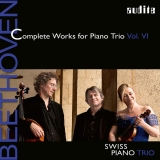(Remy Franck) – Mit zwei Bearbeitungen beschließen die drei Musiker des Swiss Piano Trio ihre Gesamtaufnahme der Beethoven-Trios. Wie schon in den ersten 5 CDs dieser Reihe nehmen sie ihren Beethoven ernst und geben ihm Substanz. Schon das Allegro con brio des nach dem Streichquintett op. 4 transkribierten Trios op. 63 schafft eine Atmosphäre, die wirkt. Sie findet sich auch im Andante und in den beiden übrigen Sätzen dieses Trios, von dem nicht bekannt ist, wie es zustande kam. Beethovens Mitwirkung an der Bearbeitung des Streichquintetts ist weder bekannt noch gesichert.
An der Bearbeitung der 2. Symphonie soll Beethoven zumindest mitgewirkt haben. Das Swiss Piano Trio spielt eine sehr dynamische Interpretation dieses Trios. Man kann nicht anders, als sich von dem wunderbar homogenen Spiel, der perfekten Zusammenarbeit und dem sensiblen Zusammenklang, aber auch dem reinen, geistvollen Spielvergnügen des Trios beeindrucken zu lassen.
The three musicians of the Swiss Piano Trio conclude their complete recording of the Beethoven Trios with two arrangements. As in the first 5 CDs of this series, they take their Beethoven seriously and give it substance. Already the Allegro con brio of the Trio op. 63, transcribed after the String Quintet op. 4, creates an atmosphere that is effective. It can also be found in the Andante and in the two remaining movements of this trio, of which it is not known how it came about. Beethoven’s participation in the arrangement of the string quintet is neither known nor confirmed.
Beethoven is said to have at least participated in the arrangement of the Second Symphony. The Swiss Piano Trio plays a very dynamic interpretation of this trio. One cannot help but be impressed by the wonderfully homogeneous playing, the perfect collaboration and the sensitive harmony, but also by the pure, spirited playing pleasure of the trio.
(Guy Engels) – Das Swiss Piano Trio macht keine Umwege, kommt direkt zur Sache. Das passt wunderbar zu Beethoven, der ja nicht als großer Meister der Diplomatie verschrien war. Dieser aufmüpfige Geist schlägt sich immer wieder in seiner Musik nieder und prägt auch die Interpretationen des Swiss Piano Trio. Martin Lucas Staub (Klavier), Angela Golubeva (Violine), Joël Marosi (Violoncello) haben selbstverständlich – außer dem dicken Hammer – noch anderes interpretatorisches Arbeitsgerät in ihrem musikalischen Werkzeugkasten.
Das Trio bleibt sich seiner musikalischen Linie in dieser Beethoven-Gesamtaufnahme treu: Es besticht durch seinen intuitiven Sinn für Spannung und Rhetorik und seine expressive Klangsprache.
Der dynamisch-robuste Gestus wird immer dann zurückgenommen, wenn die Musik sich aufmacht, eigene Wege zu gehen. Mit klugen Rubati verleihen die Interpreten dem stets vitalen Geschehen ein kantiges Relief und den nötigen Drive. Derart entwickelt sich ein munteres Gespräch, in dem jeder Musiker seine eigenen Kommentare abgeben kann.
Indes das Trio op. 63 eine Bearbeitung von Beethoven eines frühen Quintetts ist, haben wir mit Opus 63 die kammermusikalische Fassung der 2. Symphonie. Dem Swiss Piano Trio gelingt es rasch, den Zuhörer von jedwedem Gedanken an die große Orchestervorlage abzubringen. Seine Interpretation hat eine derartige Sogwirkung, dass man regelrecht in die Musik hineingezogen wird. Womit – einmal mehr – der, hier perfekte, Beweis erbracht ist, dass eine Symphonie nichts anderes ist, als Kammermusik im Großformat.
Mit dieser 6. CD beendet das Swiss Piano Trio eine Beethoven-Integrale, die Referenzcharakter haben wird.
























